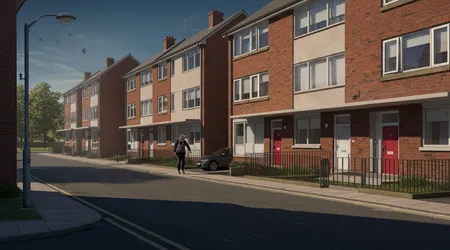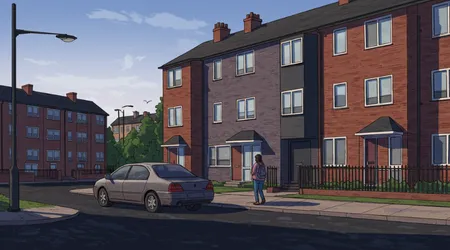How to Apply for Council Housing in the UK

To apply for council housing in the UK is to step into a complex, often daunting process that demands patience, precision, and persistence.
In 2025, with housing costs soaring and social housing in high demand, securing a council home feels like finding a rare gem in a crowded market.
This guide isn’t just about ticking boxes it’s about empowering you with practical insights, real-world strategies, and a clear path through the bureaucratic labyrinth.
From eligibility quirks to priority pitfalls, we’ll unpack the system with sharp clarity, using examples and data to light the way.
Whether you’re facing homelessness or seeking stability, understanding how to tackle this process can reshape your future. Let’s dive in and demystify it together.
The stakes are high. Shelter England reports that over 1.2 million households languish on council housing waiting lists, a stark reminder of the scarcity at play.
Yet, the system isn’t a monolith it’s a patchwork of local rules, each council wielding its own criteria like a bespoke puzzle. Grasping this variability is your first step.
This article will arm you with the tools to navigate applications, sidestep common errors, and boost your chances of success.
Expect actionable advice, grounded in reality, with a dash of wit to keep you engaged. Ready to take control? Let’s get started.
Understanding Council Housing: What’s It All About?
Council housing offers affordable homes for those who can’t compete in the private market’s ruthless race.
Managed by local councils or housing associations, these properties come with lower rents and secure tenancies.
To apply for council housing, you’re entering a system designed to prioritize need think of it as a triage for housing desperation.
Eligibility hinges on factors like income, residency, and personal circumstances. Most councils require you to be 16 or older, but rules vary.
For instance, some demand a local connection, like living in the area for years. Others, like Birmingham, might consider you regardless of postcode.
Intriguingly, your immigration status matters EU citizens with pre-settled status may face hurdles unless they prove a “right to reside.”
The catch? Demand far outstrips supply. In London alone, waiting lists can stretch for years, leaving applicants in limbo.
Knowing your council’s allocation policy whether it’s points-based or banding helps you gauge your chances. It’s not just about applying; it’s about positioning yourself smartly.
Beyond eligibility, councils assess your “housing need.” Are you overcrowded, homeless, or fleeing domestic abuse? These factors bump you up the queue.
++ How to Appeal a Benefits Rejection in the UK
For example, Jane, a single mother in Leeds, soared to Band A after proving her flat was too cramped for her kids. Understanding these triggers is critical to framing your application effectively.
Preparation is your ally. Councils often ask for ID, proof of address, and even medical letters. Missing documents can stall your case, so gather them early.
Think of it like assembling a toolkit before a big project every piece matters to get the job done right.

Step-by-Step: How to Submit a Winning Application
Kicking off your application requires focus and finesse. To apply for council housing, start by contacting your local council most offer online forms, but some still accept paper.
Websites like GOV.UK can point you to the right portal. Accuracy here is non-negotiable; errors can derail you.
Once you’re in, expect a deep dive into your life finances, family size, and housing history. Be honest but strategic. Highlight issues like overcrowding or health problems.
For instance, Tom, a Manchester veteran, included a doctor’s note about his PTSD, which fast-tracked his case. Details make the difference.
Also read: UK Disability Rights: What Support Can You Get?
Many councils use a “choice-based letting” system, letting you bid on properties. Sounds empowering, but it’s competitive like an auction where need, not cash, sets the price.
Check listings weekly on council websites or apps. Missing a bidding cycle could cost you a shot at a flat.
Don’t just apply in one area. Demand varies wildly rural councils like Cornwall often have shorter lists than urban giants like Glasgow.
Applying to multiple councils, where allowed, spreads your net wider. It’s like fishing in several ponds to boost your catch.
After submitting, expect a wait sometimes months for a decision. Councils will assign you a band or points based on need. If you’re low-priority, don’t despair.
Regularly update your application with new circumstances, like a job loss, to climb the ladder. Persistence pays off.
Priority and Points: Cracking the Allocation Code
Councils don’t hand out homes randomly they use systems to rank applicants. To apply for council housing and succeed, you need to understand this game of points and bands.
It’s less a lottery, more a calculated hierarchy of hardship.
Points-based systems award scores for issues like homelessness or disability. Banding, used by councils like Croydon, groups applicants into tiers Band A for urgent cases, down to D for minimal need.
Shelter England notes that 60% of applicants in high-demand areas linger in lower bands, waiting years.
Medical needs can rocket you upward. If your housing worsens asthma, say, get a GP’s letter. Sarah, a Bristol tenant, did this and jumped two bands.
Read more: Maternity and Paternity Leave Benefits in the UK
Similarly, fleeing violence or caring for foster kids can earn “reasonable preference,” a legal boost in priority.
But here’s the rub: not all needs are equal. Councils weigh factors differently some prioritize families, others veterans. Check your council’s allocation policy online to see what tilts the scales.
It’s like studying an opponent’s playbook before a match.
Missteps hurt. Failing to report a change, like a new baby, can freeze your priority. Worse, rejecting offers might lower your rank.
Southampton’s 2025 policy, for instance, demotes applicants to Band D after three refusals. Stay proactive and keep your file current.
Common Pitfalls and How to Dodge Them
Applying isn’t just about forms it’s about avoiding traps. To apply for council housing successfully, steer clear of errors that can sink your chances.
One misstep, like missing a deadline, can set you back months.
Incomplete applications are a killer. Councils need everything ID, income proof, references. Forget one, and you’re stalled. Double-check before submitting, like proofreading an exam.
A Birmingham applicant lost six months over a missing payslip don’t be that person.
Another snag? Misunderstanding bidding. Choice-based letting sounds simple, but bidding on oversubscribed properties wastes time.
Focus on less popular areas or smaller flats. Data from Leeds shows 80% of successful bids target low-demand zones. Be tactical, not hopeful.
Lying is a cardinal sin. Exaggerating needs, like claiming homelessness without proof, risks suspension.
Councils verify claims rigorously think of them as detectives, not clerks. Honesty, paired with clear evidence, builds a stronger case.
Finally, don’t ghost your council. Ignoring letters or calls can close your file. Merton Council, for example, shuts applications if applicants move without notice.
Stay in touch, update your details, and treat the process like a job you can’t afford to lose.
Beyond the Application: What Happens Next?
Submitting your form is just the start. To apply for council housing sets you on a path of waiting, bidding, and sometimes appealing. Knowing what follows helps you stay sharp and ready for action.
Waiting lists are long think marathon, not sprint. In 2025, Shelter reports average waits of 2-5 years in cities like London.
Use this time wisely: save for rent deposits, as most tenancies require upfront payments. Preparation now prevents panic later.
Bidding keeps you active. Once approved, you’ll get a login for your council’s letting portal. Bid on properties matching your needs, but be realistic.
A family of five won’t snag a one-bedroom flat, no matter how persistent. Prioritize wisely.
If offered a home, act fast decisions often have tight deadlines, sometimes 48 hours. Refusing offers can lower your priority, as Southampton’s policy shows.
Weigh pros and cons quickly, like choosing a seat on a packed train hesitation costs you.
Appeals are your safety net. If your band feels unfair, challenge it. Provide new evidence, like medical records, and request a review within 21 days.
Citizens Advice notes 30% of appeals in 2024 succeeded, so don’t shy away from pushing back.
Boosting Your Chances: Insider Tips for Success

The system rewards the savvy. To apply for council housing with an edge, think like a strategist, not just an applicant. Small moves can tip the scales in your favor without breaking rules.
Flexibility is key. Willing to live in less sought-after areas?
Your wait shrinks. Cornwall’s waiting list, for instance, is half the length of Manchester’s. It’s like choosing a quieter café over a trendy one same coffee, less queue.
Medical evidence can be a game-changer. A letter from a therapist or doctor detailing how your flat affects your health like damp triggering asthma adds weight.
One Liverpool applicant doubled her points this way. Get those documents lined up early.
Engage with housing officers. Polite, regular check-ins show you’re serious. Ask for updates or advice human connection matters.
Picture it like networking at a job fair; a friendly face stands out in a sea of forms.
Consider mutual exchanges if you’re already a tenant. Platforms like HomeSwapper let you trade homes with others, bypassing lists entirely.
It’s a shortcut, like bartering for a better seat at a concert direct and effective.
Lastly, explore housing associations alongside councils. Some, like Peabody, accept direct applications. Diversifying your options is like planting multiple seeds more chances for something to grow.
The Bigger Picture: Why Council Housing Matters
Council housing isn’t just about roofs it’s about dignity and stability. To apply for council housing is to stake a claim in a system meant to level the playing field. But in 2025, it’s under strain, and that’s worth unpacking.
The UK’s housing crisis fuels demand. With private rents eating 40% of average incomes in London, per ONS data, council homes are a lifeline.
Yet stock dwindles Right to Buy schemes have slashed numbers since the 1980s.
Why should a system built to help feel so out of reach?
| Council Housing Stats (2025) | Details |
|---|---|
| Households on Waiting Lists | 1.2 million |
| Average Wait Time (Urban) | 2-5 years |
| Homes Lost to Right to Buy | 2 million+ |
This scarcity sparks tough questions. Should councils build more?
Prioritize differently? The debate rages, but for applicants, it’s personal a chance at security in an uncertain world. Your application is a step toward that.
Advocacy matters too. Joining tenant groups or campaigns, like Shelter’s, amplifies your voice. It’s not just about your home it’s about a fairer system for all. Think of it as planting a tree you’ll share with others.
The process can feel like navigating a stormy sea, but every step forward counts. To apply for council housing isn’t just paperwork it’s a fight for stability.
Keep pushing, stay informed, and don’t lose sight of the prize.
Wrapping Up: Your Path to a Council Home
Stepping into the world of council housing feels overwhelming, but it’s a journey you can master.
To apply for council housing demands grit, clarity, and a sprinkle of cunning to work the system smartly. From decoding eligibility to dodging pitfalls, this guide has laid out the map now it’s your turn to walk the path.
The 1.2 million households waiting alongside you prove the stakes, but also the value of perseverance.
Armed with practical tips, like bidding tactically or leveraging medical evidence, you’re not just another name on a list you’re a contender.
Whether it’s Jane’s cramped flat or Tom’s health struggles, real stories show success is possible. The system’s flaws, like long waits or shrinking stock, won’t vanish overnight, but your proactive steps can outpace them.
So, gather your documents, check your council’s rules, and dive in with confidence. Isn’t it time you claimed the stability you deserve?
Frequently Asked Questions
How long does it take to get a council house?
Wait times vary 2-5 years in cities, less in rural areas. Priority bands and bidding activity heavily influence speed.
Can I apply to multiple councils?
Yes, most allow it, but check each council’s rules. Applying widely, like fishing in multiple streams, boosts chances.
What if I’m not a UK citizen?
Eligibility depends on immigration status. Settled status or specific visas qualify; pre-settled EU citizens may need extra proof.
Can I appeal a low-priority banding?
Absolutely. Request a review within 21 days, providing evidence like medical letters. About 30% of appeals succeed.
Do I need a local connection?
Some councils require it years of residency or work ties. Others, like Birmingham, are more flexible. Always verify locally.
